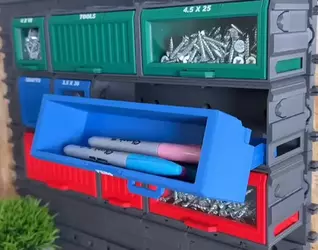Ogay, real shit. All that talk about how garbage Mald's code is made me, a complete knuckledragger who doesn't understand programming and considers it black magic, curious.
Lay it out in the most simplistic, retardproof way. Tell me how and why it's bad and how would you improve it. Provide examples. Any insight helps. I am paying in

s.
View attachment 7598850
Imagine you have some sort of workshop, and you store everything in a big set of identical/near identical, rearrangable drawers. Each drawer contains a tool or a part, and as part of your job, you need to pull specific things from these drawers at specific times.

In addition, you may need to add in new things, each of which will need their own drawers, in the future. And you need to leave instructions so whoever's performing this job can know which drawers to go to.
And this contains 500 drawers and counting, and each one of those is in at least one set of instructions. So you need to get this right from the getgo, cos you're gonna be
real fucked if you need to change your filing system later.
A normal person would label every drawer with a descriptive title, like the image. Like, if you're making terracotta gnome dolls from a design you made in 2004, you might have drawers named something like 'Terracotta Gnome (2004) Heads', 'Terracotta Gnome (2004) Feet', 'Terracotta Gnome (2004) Nose', etc. etc. Something that can be used to describe each drawer's contents easily and accurately. because the titles are descriptive, it's very easy to look back over a set of instructions and spot when something's wrong (e.g. when your instructions say to get shoes from the 2014 design), so any issues like that are easily fixed. And chances are if you make a typo that what will come out of it is something that obviously doesn't correspond to any drawer (e.g. 'Terracotta Gnome (2004) Feel", so none of your workers will actually go through with the dodgy instructions until the mistake is corrected. And because they're rearrangeable and the titles require no order, you can put all your screws and all your tools grouped together and arranged logically, and make relatively small adjustments when needed to accomodate new things.
What Mald did instead was
number every drawer as he got it out of laziness (who can be bothered to print all those little labels and stick them on?), and then create a document that explains what that number corresponds to. So 1 is 4*25 screws, 2 is nine-inch nails, 3 is 40-grit sandpaper, etc.. This has obvious drawbacks;
- One, whenever he's writing a new set of instructions, he has to go back to the document and painstakingly check for each individual item, because the titles aren't descriptive. Just because he knows this design needs the 2004 terracotta gnome feet, he has to go back and find exactly what number that corresponds to before he can write it down. God forbid he makes a typo, as there's a good chance he has no idea what it was meant to be.
- Two, he needs to keep everything arranged in the chronological order of when he acquired it, because otherwise the numbers are all fucked up and he can't easily find where drawers are if they're not in order - meaning that some of his screws could be on one side of his cabinet, and another could be on the other side of the damn building. And if he no longer needs the contents of a drawer, he can't get rid of it easily without leaving an inexplicable gap. .
These two things are force
dividers - they drastically slow progress down, not speed it up, because you constantly have to double-check yourself. Once the instructions are set up, it might not take that much more time, but the process of making those instructions is torturously slow.
There are other things he could be doing better - storing everything in 500 individuals drawers is obviously not always ideal in the first place, and you might be able to set up systems where you can automatically bag everything relevant into one group and don't even have to check more than one or two drawers - but he can't even hope to manage that without having to go through the painstaking process of figuring out what parts go where.



